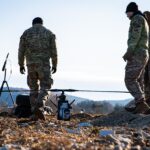On Monday, the United States and Israel launched Juniper Oak 23, a multi-day series of bilateral military exercises. US-Israel military exercises aren’t unusual in the region, but this one stands out. This exercise’s size, scope, and complexity set it apart from any that came before. It stands to be a demonstration of two of the world’s most advanced militaries working together in ways most cannot.
WHY THIS MILITARY EXERCISE IS DIFFERENT
Military capabilities analysts apply some basic litmus tests when evaluating a military force’s level of competence. The first is, “can this force perform combined arms maneuver?” For instance, can infantry coordinate with armor and artillery on the battlefield? It seems basic, but we’ve seen supposedly credible militaries fail this basic test, such as Russia has in Ukraine.
If successful, this joint exercise will have important foreign policy implications for both the United States and Israel, sending messages to friends, foes, and those that remain somewhere in between.
Another litmus test (and of course, there are others in between, but I hope, dear reader, you’ll forgive me for simplifying this for our purposes here) is “jointness.” Can land forces (army) coordinate and receive air support (air force) or seaborne fires (navy) in battle? How well can separate and distinct military services operate together? The more services and components there are working together, the more sophisticated and capable a military is. Yet another test of military capability is “interoperability.” How closely and effectively can one country’s military work with another’s? Are their forces seamlessly integrated? Can they communicate effectively and operate safely without undue risk of friendly fire? Have their movements and activities been planned together such that they can operate as one force? Can they improvise and react to changing battlefield conditions and still maintain cohesion?
Why is any of this significant to Juniper Oak? Any competent military should be able to perform combined arms maneuvers. Few militaries can effectively operate jointly, that is, using their own army, airforce, and/or navy together, and even less can do that with each other (interoperability). In the exercise launched this week, the US and Israeli militaries will perform joint exercises in all domains: land, air, sea, space, and cyber. One military combining all of those military components should turn heads, but this week, two countries are doing that together. Juniper Oak may prove to be one of the world’s greatest demonstrations of modern military capability. Furthermore, a typical joint military exercise takes about one year to plan. The planning for Juniper Oak began in November 2022, which demonstrates the close level of coordination between the US military and IDF, and that they are able to plan operations quickly and effectively, not just execute them.
REGIONAL IMPACT
While this is a tremendous demonstration of US and Israeli military sophistication, it’s important to remember that for the United States, this isn’t happening in a vacuum. While delivering all of this firepower to the Central Command area of operations, the United States continues to support Ukraine with arms and perform all of its regular activities around the world — the equivalent of walking, chewing gum, juggling knives, patting one’s head, and rubbing one’s belly — all at once. Are these realistic objectives? Juniper Oak may demonstrate that they are.
There are additional lessons and messages that both partners and adversaries can take away from Juniper Oak. For Israel’s emerging partners in the Gulf who have sought to normalize and build greater relations following the signing of the Abraham Accords, seeing this awesome display of military capability is a showcase for what they stand to gain should they choose to further develop their defense relationships with Israel. While they all have a long way to go before they could perform at this level, surely, an exercise of this magnitude must be reassuring to them that a future in partnership with the United States and Israel is a more secure one. Though one should be careful not to link it to US support for Prime Minister Benjamin Netanyahu specifically since planning for these exercises predates the formation of his government.
For those countries that have yet to normalize with Israel (looking at you, Riyadh), a demonstration like this puts on full display what they could stand to gain. Simply having the level of military sophistication to be able to perform in an exercise like Juniper Oak is something to which all Gulf nations aspire. Here, CENTCOM and the Israeli Defense Forces are previewing the potential future for their neighbors’ militaries, should they choose to work proactively with the United States and Israel.
Of course, embedded in all of this, there’s a message for Iran too. Juniper Oak demonstrates to leaders in Tehran that the United States has a credible military option, should the regime continue down the road to a nuclear weapon. If Iran’s leaders believed they could string along the west forever in fruitless negotiations, exploiting US and European good-faith efforts to return all parties to comply with the Iran nuclear deal or the Joint Comprehensive Plan of Action, and soldier on under immense sanctions while incrementally advancing toward a nuclear weapon, they might think again. Juniper Oak demonstrates that there are additional tools in the toolkit.
Through the week, we will see just how effective the US and Israeli militaries are in working together — on land, in the air, at sea, and in domains that are typically invisible or inaccessible to most: cyber and space. If successful, this joint exercise will have important foreign policy implications for both the United States and Israel, sending messages to friends, foes, and those that remain somewhere in between.
Jonathan Lord is a senior fellow and director of the Middle East Security program at the Center for a New American Security (CNAS). He previously was a staff member for the House Armed Services Committee, the Iraq country director in the Office of the Under Secretary of Defense for Policy, and a political-military analyst in the Department of Defense.




















